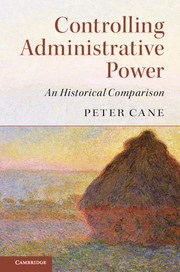Book contents
- Frontmatter
- Dedication
- Contents
- Preface
- Table of cases
- Table of legislation
- 1 Introduction: concepts and methodology
- 2 The English system of government
- 3 The US system of government
- 4 The Australian system of government
- 5 The development and institutional structure of control regimes
- 6 Administrative interpretation
- 7 Administrative fact-finding and policy-making
- 8 Administrative rule-making
- 9 Administrative adjudication
- 10 Private law controls
- 11 Controlling information
- 12 The New PublicManagement
- 13 Controlling the controllers
- 14 Concluding reflections on methodology and themes
- Bibliography
- Index
2 - The English system of government
Published online by Cambridge University Press: 05 March 2016
- Frontmatter
- Dedication
- Contents
- Preface
- Table of cases
- Table of legislation
- 1 Introduction: concepts and methodology
- 2 The English system of government
- 3 The US system of government
- 4 The Australian system of government
- 5 The development and institutional structure of control regimes
- 6 Administrative interpretation
- 7 Administrative fact-finding and policy-making
- 8 Administrative rule-making
- 9 Administrative adjudication
- 10 Private law controls
- 11 Controlling information
- 12 The New PublicManagement
- 13 Controlling the controllers
- 14 Concluding reflections on methodology and themes
- Bibliography
- Index
Summary
Introduction
For present purposes, the history of the English system of government may be broadly divided into four periods: the first from its notional birth in the eleventh century to the early seventeenth century; the second from the early seventeenth century to the early twentieth century; the third from the early twentieth century to the 1970s; and the fourth from the 1970s to the present. Purely for convenience, I will refer to these four periods respectively as the mediaeval, the transitional, the modern and the contemporary. To the extent that it suggests that history is discontinuous, such periodisation is, of course, an inherently problematic historiography. However, nothing in the account turns on a precise carving up of the historical record, and it is satisfactory for my purposes to think more abstractly in terms of phases rather than time periods. Still, it is best to admit that brief ‘historical’ accounts of the sort given in this and succeeding chapters, covering periods of time as long as a millennium, will inevitably be highly interpretive, stylized and impressionistic and will risk being tendentious: if all you have is a hammer, everything looks like a nail! My aim in this chapter is to account for the system's main structural features in terms of the distinction drawn in Chapter 1 between concentration and diffusion as models for the distribution of public power, and between checks-and-balances and accountability as techniques for controlling public power. Each reader must judge the plausibility and success of that account for themselves.
The focus of this chapter on the English system of government makes historical sense for the period between the Conquest and the union of Scotland and England in 1707, forming Great Britain. (The United Kingdom of Great Britain and Ireland (UK for short) was created in 1801. Since 1922, when the Irish Free State gained independence, becoming the Republic of Ireland in 1949, the UK has consisted of Great Britain and the ‘province’ of Northern Ireland.) It also makes quite good sense for the period since devolution of power to Scotland, Wales and Northern Ireland in 1998. Before 1707 the English governmental system was, and since 1998 it has been, identifiably separate from the governmental systems of the other component parts of a larger polity.
- Type
- Chapter
- Information
- Controlling Administrative PowerAn Historical Comparison, pp. 24 - 57Publisher: Cambridge University PressPrint publication year: 2016

